I started diving the waters near my home off the California coast some 20 years ago and have always been fascinated by the oceans greatest predator, the Great white shark. Diving in the waters of Northern California you are keenly aware of the presence of White sharks in our ocean. White shark attacks on people are relatively common here compared to other places in the world and make for sensational headlines when they occur. Some of the most important white shark research has taken place just 25 miles off the coast here at the Farallon Islands where the worlds largest white sharks belly up to the table each fall to feed on elephant seals. In the late 1980’s South Australia was THE place to dive and see White sharks but the cost, even back then, was a staggering $5,000. The diving conditions were rough and the visibility underwater was highly variable making the trip a risky adventure. Back then I thought I would someday make the trip to South Australia or maybe South Africa, the other White shark Mecca. All that changed in 2001 when it was discovered that Isla Guadalupe off the coast of Mexico was the new hot spot to dive with White sharks.
Guadalupe island is located 120 miles off the coast of Baja and 220 miles South West of San Diego. The island is 22 miles long and rises to more than 4,000 feet above the pacific ocean. The waters around the island are clear and deep. This volcanic island rises from depths of over 12,000 feet in open ocean. The remoteness of the island and it’s deep surrounding waters make it the perfect place for pelagic animals to take advantage of the nutrient rich current swept waters. Bluefin and yellowfin tuna frequent the waters of Guadalupe and are favorite menu items for White sharks. Guadalupe fur seals also live at the island and are another source of food for the sharks. The history of diving with White sharks at Isle Guadalupe is relatively short. During the 1980’s two free diving spear fishermen were attacked by white sharks, one fatally. Fisherman also reported reeling in tuna only to have a White shark swim up and help themselves to an easy snack. Starting in 2001 it became feasible to run commercial trips to this remote island and visit with the sharks. For the time being, Guadalupe is THE spot to visit with the oceans greatest predator.
Tuesday October 4th – DAY 1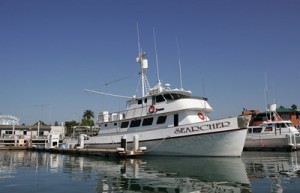
10am Gear and people are piled up on the pier at Fisherman’s Landing in San Diego, home to the 95 foot sport fishing boat “Searcher”. The ships crew is busy loading mackerel onto the boat that will be used as shark bait. Everyone is anxious to load gear and get underway, which for most, would be a once in a lifetime experience to dive underwater with one of the planets greatest predators, the White shark. Once aboard we check a white board in the galley for our bunk assignments. The boat normally takes up to 32 passengers on sport fishing and natural history tours but for White shark trips, the boat only takes 16 paying passengers. We each have our own bunk room with ample room to store camera gear, laptop computers and the associated personal gear for trip such as this. We were warned upon boarding that our 23 hour open ocean crossing to the island would be rough and to stow our gear securely.
With gear stowed we mostly hung out in the large galley area introducing ourselves and sharing past diving experiences. For this trip we have a quite diverse group of enthusiastic divers aboard: A group of 10 friends who are underwater photography enthusiasts from Germany, A husband wife underwater photography/vidography team (coincidentally, also from Germany), a veterinarian and mortgage broker from back East and a pair of AV professionals from Hollywood. Our group was rounded out with professional wildlife photographer from New Mexico who was on his second trip to Guadalupe and a veteran of other trips around the world to visit with White sharks.
Wednesday October 5th – DAY 2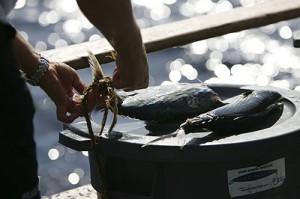
10am We reach the North East corner of the island and take shelter from the swells of the open ocean. There are two other boats already here, diving with the sharks. One of the boats is chartered by the BBC to film a documentary about the sharks of Guadalupe. We call over to the BBC group and make arrangements to transfer a third cage to our boat, lovingly nicknamed the “chum bucket” due to the fact that it does not have a door on top like the other two cages on the boat.
Alan our guide from Great White Adventures, goes over the diving procedures and schedule for the trip. We are split into two teams of eight divers. Each team will have one hour in the cage and one hour out. This rotations will take place while the sharks are around the boat during daylight hours. The two main cages are 8 feet by 5 feet and hold 4 divers each. The cages area connected to the stern of the boat and float just below the surface. Air is supplied to us via compressor on the boat to standard scuba style regulators. This “hookah” style system allows us unlimited time in the water without the worry of running out of air and changing air tanks.
The others from the US and myself were in the first rotation which was started with a 1/2 hour shake down dive to get acclimated to life in a cage. We donned thick wetsuits or dry suits which might seem over kill for 70 degree water but we would not be swimming or otherwise generating much body heat and the amount of time spent in the water made this level of insulation a necessity. Next a 50lb weight harness/belt and ankle weights were put on making you feel like a pack mule on the deck of the boat but once underwater the extra weight helped to counter act the constantly bouncing cages and aid in steady camera operation. We would end up spending over 30 hours underwater in the cages during our 5 days of diving.
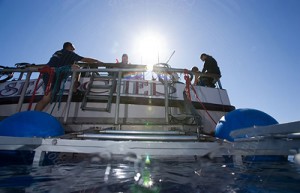 After each group completed their check out dives we went into our 1 hour rotations. I had read all the past trip reports that Google could dig up on the internet in preparation of my trip. I read report after report of sharks showing up in the first 15 minutes of divers being in the water or even showing up before the cages could get set up. I thought with my luck we would get skunked. So after two hours past without any sharks, the strict one hour rotations halted and basically anyone who wanted to hang out in the cages could. I had just finished my rotation and had taken my wet suit off so I could get some lunch in the galley. Sure enough this is when the first shark showed up. The deck of the boat instantly was transformed into a stirred up ant nest with everyone anxious to see their first Great white shark. I was able to get some of my best surface shots of the trip during this first encounter, though this only wet my appetite for more action.
After each group completed their check out dives we went into our 1 hour rotations. I had read all the past trip reports that Google could dig up on the internet in preparation of my trip. I read report after report of sharks showing up in the first 15 minutes of divers being in the water or even showing up before the cages could get set up. I thought with my luck we would get skunked. So after two hours past without any sharks, the strict one hour rotations halted and basically anyone who wanted to hang out in the cages could. I had just finished my rotation and had taken my wet suit off so I could get some lunch in the galley. Sure enough this is when the first shark showed up. The deck of the boat instantly was transformed into a stirred up ant nest with everyone anxious to see their first Great white shark. I was able to get some of my best surface shots of the trip during this first encounter, though this only wet my appetite for more action.
The one hour rotation began again once the sharks showed up but unfortunately they only hung out for 1/2 an hour. We would then go nearly 24 hours before another white shark would come to visit us.
Thursday October 6th – DAY 3
Divers spirits were a little low after a disappointing first day of little shark action. The crew reassured us that it would just be a matter of time before the sharks showed up. The weather was perfect, the ocean was flat calm, no wind and no swells. Dropping into the cage you could look toward the bow of the boat 100 feet away and see the anchor rope dropping straight down into the ink blue water. We are anchored in 300 feet of perfect water, no reef, no rocks, no sandy bottom and no kelp to distract your view of the sharks. Our blue view is only broken by bait fish attracted to the two mackerel snacks dangling 10 feet in front of the cages and the steady stream of chum being poured overboard in an effort to coax the sharks from the deep blue to our cages. The skipper had reports that the tuna fishing had been very poor at the island recently, there was also no current to speak of which made it difficult for our chum scent to reach out and get the sharks attention. The unknown reason why the sharks were not here in their usual numbers just added to the mystique surrounding the White shark.
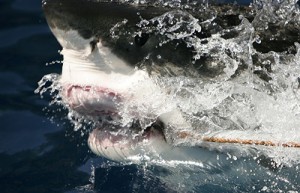 Underwater it is very quiet standing in the cage for hours, the only sounds are coming from the sips of air you take from your regulator. Everyone is on the lookout for dark shadows on the edge of visibility that indicate the sharks are back. Suddenly around noon, the silence and stillness is broken by shuffling of feet in the cage and the clanging of underwater cameras being passed through the openings of the cage to get into position. A 10 footer glides in from the blue to check us out with it’s mouth slightly ajar, a look that would make an orthodontists eyes light up with dollar signs . As was typical for our trip, the shark did a drive by of the bait fish before circling for a final approach. On the stern of the boat a shark wrangler would pull on the rope that had the 2 foot mackerel on the end as the shark was closing in for a snack. Some of the sharks were almost lazy about this and would give a half hearted thrust with their tail to try and catch the evading mackerel. Other sharks were more aggressive pulling “crazy Ivan” maneuvers, a not so scientific term for when they would violently do a 180 degree turn after missing the mackerel in an attempt to get a quick second chance at a free meal. Capturing the action with my digital camera was challenging but I was grateful that I wasn’t shooting with film.
Underwater it is very quiet standing in the cage for hours, the only sounds are coming from the sips of air you take from your regulator. Everyone is on the lookout for dark shadows on the edge of visibility that indicate the sharks are back. Suddenly around noon, the silence and stillness is broken by shuffling of feet in the cage and the clanging of underwater cameras being passed through the openings of the cage to get into position. A 10 footer glides in from the blue to check us out with it’s mouth slightly ajar, a look that would make an orthodontists eyes light up with dollar signs . As was typical for our trip, the shark did a drive by of the bait fish before circling for a final approach. On the stern of the boat a shark wrangler would pull on the rope that had the 2 foot mackerel on the end as the shark was closing in for a snack. Some of the sharks were almost lazy about this and would give a half hearted thrust with their tail to try and catch the evading mackerel. Other sharks were more aggressive pulling “crazy Ivan” maneuvers, a not so scientific term for when they would violently do a 180 degree turn after missing the mackerel in an attempt to get a quick second chance at a free meal. Capturing the action with my digital camera was challenging but I was grateful that I wasn’t shooting with film.
Since the sharks are constantly moving and you never know which direction they will come from or which hang bait they will go after, a zoom lens is a must. I was shooting with a 17-40mm zoom with a full frame sensor camera. I also brought a 15mm fish eye lens but found the 17mm plenty wide for shooting from the cages. I set my camera to manual mode, ISO started at 200 for mid day shooting and would go up to 800 during the early morning or late afternoon hours. I tried to keep my shutter speed at 160th of second or higher to freeze the action. Aperture was usually at f5.6, I did not want my camera to exploit the weakness of my lens wide open and at f5.6 I would get more depth of field. And most importantly, the combination of 160th @ f5.6 gave a good exposure to the mid water background. I used one small strobe for a little fill light set on 1/4 – 1/16th power. I was a bit paranoid about blowing the highlights which is easy to do with a fish that has a dark top half and a white bottom half. In order to make my camera as responsive as possible so as not to miss any shots I manually selected a single center autofocus point and coupled this with servo focus. Continuous shooting mode gave me 4 frames per second to capture decisive moments. Having my camera in this configuration worked very well. The only things I would change in the future would be to bump my shutter speed up to 200th and to bump up the power on my strobe. One thing for sure is that I could not imagine being in the cage with a film camera and only getting 36 shots per dive. With digital I was able to get over 400 which usually lasted me an entire day. It was nice not to scramble around after each dive to reload film in my camera. I could keep everything buttoned up until the end of the day, lessening the chance of a flooded camera housing.
Friday October 7th – DAY 4
Day 4, our 3rd diving day, was also slow with only an hour or so of shark action all day. Had this been a three day trip I certainly would have been disappointed, only because of what I had heard of being “typical” at Guadalupe had not been what we were experiencing. But out here there are no guarantees, this is not Sea World!
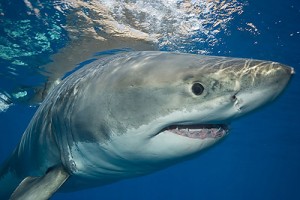 Today I had an opportunity to dive in the 3rd cage, lovingly referred to as the “chum bucket”. This cage was much smaller than the two main cages and is dangled over the side of the boat on a cable and dropped to a depth of 15 feet. There is no top on this cage. You dive with a safety diver who keeps an eye out while you prop yourself up on the top rim of the cage to take photographs. This cage offers a really unique upward view of the sharks as they circle the two larger cages, at least that is what I think it would look like since the two times I was in the “chum bucket” the sharks were not around. By the end of the day we decided to move the boat closer to where the other two boats had been anchored when we arrived. They have subsequently pulled anchor and headed for home. We had the entire coast to ourselves. No one wanted to watch any of the video’s from past trips on the TV in the galley, this would have only reminded us of what we were missing. Still we held out hope that the last two days would be more productive. Up until this point we had only been teased by the sporadic appearance of Whitey. You could almost feel the dark cloud that hung over our boat by the third diving day. You could tell spirits were down, the look on the crew’s faces told what they were afraid to say….this was the slowest White shark trip to date.
Today I had an opportunity to dive in the 3rd cage, lovingly referred to as the “chum bucket”. This cage was much smaller than the two main cages and is dangled over the side of the boat on a cable and dropped to a depth of 15 feet. There is no top on this cage. You dive with a safety diver who keeps an eye out while you prop yourself up on the top rim of the cage to take photographs. This cage offers a really unique upward view of the sharks as they circle the two larger cages, at least that is what I think it would look like since the two times I was in the “chum bucket” the sharks were not around. By the end of the day we decided to move the boat closer to where the other two boats had been anchored when we arrived. They have subsequently pulled anchor and headed for home. We had the entire coast to ourselves. No one wanted to watch any of the video’s from past trips on the TV in the galley, this would have only reminded us of what we were missing. Still we held out hope that the last two days would be more productive. Up until this point we had only been teased by the sporadic appearance of Whitey. You could almost feel the dark cloud that hung over our boat by the third diving day. You could tell spirits were down, the look on the crew’s faces told what they were afraid to say….this was the slowest White shark trip to date.
Saturday October 8th – DAY 5
My shoulders are sore from wearing the 50lb weight harnesses for the last three days but I am still fired up to get into the cages for what I hope will be a better day than the last three. With Led Zeppelin playing on the underwater speaker we begin our first dive of the day. We soon get a visitor, a nice 10 footer. The wranglers do a good job of keeping the shark interested in the bait and a flurry of camera flashes go off as the shark is lured closer to the cages. To our utter delight, the action continues for most of the day with several different sharks paying us a visit. One of which was a 14 foot monster, that looked like it had been in a demolition derby. It’s dorsal fin was nearly split in half down the middle and it’s flanks were riddled with bite marks and scars. If only this beauty could tell us it’s life story, what a story it would be. Certainly, life as a white shark is not an easy one.
 Spirits are finally running high aboard the Searcher with wide eyes and non stop chatter from the divers as they exit the cages. For the first time, I have to swap out full memory cards half way through the day and I am starting to get picky about what shots I want to take. After the last dive of the day, Pacifico and Sierra Nevada beers are opened, not to drown our frustrations but this time in celebration of a great day.
Spirits are finally running high aboard the Searcher with wide eyes and non stop chatter from the divers as they exit the cages. For the first time, I have to swap out full memory cards half way through the day and I am starting to get picky about what shots I want to take. After the last dive of the day, Pacifico and Sierra Nevada beers are opened, not to drown our frustrations but this time in celebration of a great day.
Sunday October 9th – DAY 6
Our last day at the island and everyone was still energized after the previous day. Once again, we were rewarded with great shark action all morning long. By afternoon things quieted down but we were all feeling pretty satisfied that we had finally experienced what we had come here for. 45 minutes into my last cage rotation a 10 footer showed up for an encore and chomped one last mackerel before hitting the road to do business elsewhere. Gear was packed up and cameras stowed safely as the trip back was going to be rough. We headed out at 5pm and within 1/2 an hour we were being hammered by huge swells as we fought our way “uphill” to San Diego. At 7pm dinner was served, spaghetti with sausage. The guy next to me asked “is that spicy?” as I bit into my sausage . No sooner had the words come out than the blood left his face ashen as he excused himself and retreated to his cabin. Others were not able to fend off the non stop bombardment of movement on the inner ear and had to give in to the ritual of vomiting over the side of the boat. As soon as dinner was over I retreated to my bunk, closed my eyes and relived my visit with the White shark.
Monday October 10th – Day 7
 By morning the ocean had calmed and we made steady progress toward home. Just off the Coronado’s islands we came upon a huge pod of Pacific bottle nose dolphins, some of which could not resist the temptation to play in our bow wake. We arrived in port at 3:30 in the afternoon to waiting passengers eager to hear how our trip went. Tomorrow would be their turn to board the boat and make the 23hr trip to Guadalupe. I returned home wanting to return to Guadalupe and visit once again with “Whitey”. There are many images that I did not capture and some I would like to do over. No one knows for sure if we are riding a peak in the abundance of White sharks at Guadalupe or if this is just the beginning of a much larger come back for this incredible animal. Hopefully as public awareness and support for the White shark grows, so too will their population.
By morning the ocean had calmed and we made steady progress toward home. Just off the Coronado’s islands we came upon a huge pod of Pacific bottle nose dolphins, some of which could not resist the temptation to play in our bow wake. We arrived in port at 3:30 in the afternoon to waiting passengers eager to hear how our trip went. Tomorrow would be their turn to board the boat and make the 23hr trip to Guadalupe. I returned home wanting to return to Guadalupe and visit once again with “Whitey”. There are many images that I did not capture and some I would like to do over. No one knows for sure if we are riding a peak in the abundance of White sharks at Guadalupe or if this is just the beginning of a much larger come back for this incredible animal. Hopefully as public awareness and support for the White shark grows, so too will their population.


